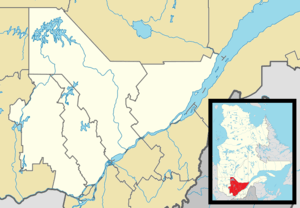Mascouche
Mascouche is an off-island suburb of Montreal, in southern Quebec, Canada. The city is located on the Mascouche River within the Les Moulins Regional County Municipality and has a population of 42,491,[3] ranking 30th among Quebec municipalities.
Mascouche | |
|---|---|
City | |
 Coat of arms | |
 Location (red) within Les Moulins RCM | |
 Mascouche Location in central Quebec | |
| Coordinates: 45°45′N 73°36′W[1] | |
| Country | |
| Province | |
| Region | Lanaudière |
| RCM | Les Moulins |
| Constituted | July 1, 1855 |
| Government | |
| • Mayor | Guillaume Tremblay |
| • Federal riding | Montcalm |
| • Prov. riding | Masson |
| Area | |
| • Total | 107.70 km2 (41.58 sq mi) |
| • Land | 106.64 km2 (41.17 sq mi) |
| Population (2011)[3] | |
| • Total | 42,491 |
| • Density | 398.4/km2 (1,032/sq mi) |
| • Pop 2006–2011 | |
| Time zone | UTC−5 (EST) |
| • Summer (DST) | UTC−4 (EDT) |
| Postal code(s) | J7K, J7L |
| Area code(s) | 450 and 579 |
| Highways | |
| Website | www |
The name comes from Algonquin word maskutchew meaning "bear plain" in singular. Compare plular form to maskutew for the Les Maskoutains Regional County Municipality located nearby.
History
Mascouche received city status on December 9, 1970, under mayor Gilles Forest.
Infrastructure
Montréal/Mascouche Airport, the largest regional airport in Quebec, is three kilometres southeast of the city.
Autoroutes 640 and 25, both major national transportation routes, meet just south of the centre of the city.
Mascouche is connected to Montreal's Central Station by commuter rail via the Mascouche station of the Réseau de transport métropolitain's Mascouche line.
L'Étang-du-Grand-Coteau, an urban park situated in the city centre on Mascouche Boulevard, has the same area as Mount Royal Park in Montreal.
Demographics
Population
| Canada census – Mascouche, Quebec community profile | |||
|---|---|---|---|
| 2011 | 2006 | ||
| Population: | 42,491 (+25.8% from 2006) | 33,764 (+14.2% from 2001) | |
| Land area: | 106.64 km2 (41.17 sq mi) | 106.64 km2 (41.17 sq mi) | |
| Population density: | 398.4/km2 (1,032/sq mi) | 316.6/km2 (820/sq mi) | |
| Median age: | 36.5 (M: 36.2, F: 36.9) | 36.6 (M: 36.3, F: 36.9) | |
| Total private dwellings: | 16,290 | 12,398 | |
| Median household income: | $70,673 | $63,780 | |
| References: 2011[3] 2006[4] earlier[5] | |||
| Historical Census Data - Mascouche, Quebec[6] | ||||||||||||||||||||||||||
|---|---|---|---|---|---|---|---|---|---|---|---|---|---|---|---|---|---|---|---|---|---|---|---|---|---|---|
|
|
| ||||||||||||||||||||||||
Language
| Canada Census Mother Tongue - Mascouche, Quebec[6] | ||||||||||||||||||
|---|---|---|---|---|---|---|---|---|---|---|---|---|---|---|---|---|---|---|
| Census | Total | French |
English |
French & English |
Other | |||||||||||||
| Year | Responses | Count | Trend | Pop % | Count | Trend | Pop % | Count | Trend | Pop % | Count | Trend | Pop % | |||||
2016 |
46 375 |
42 740 | 92.10% | 1 150 | 2.47% | 355 | 0.76% | 1 840 | 3.96% | |||||||||
2011 |
42,185 |
39,580 | 93.82% | 1,010 | 2.39% | 275 | 0.65% | 1,320 | 3.13% | |||||||||
2006 |
33,600 |
31,470 | 93.66% | 960 | 2.86% | 125 | 0.37% | 1,045 | 3.11% | |||||||||
2001 |
29,285 |
27,760 | 94.79% | 820 | 2.80% | 210 | 0.72% | 495 | 1.69% | |||||||||
1996 |
27,930 |
26,430 | n/a | 94.63% | 905 | n/a | 3.24% | 115 | n/a | 0.41% | 480 | n/a | 1.72% | |||||
Mayors
- André Duval (1955-1965)
- Gilles Forest (1965-1983)
- Bernard Patenaude (1983-1992)
- Richard Marcotte (1992-2012)
- Denise Paquette (2012-2013)
- Guillaume Tremblay (2013–present)
Education
The Commission scolaire des Affluents operates Francophone public schools. They include:
Primary schools:
- L'école Aux 4 Vents
- L'école De la Source
- L'école La Mennais
- L'école des Hauts-Bois
- L'école Soleil-Levant
- L'école Le Rucher
- L'école de La Seigneurie
Secondary schools :
- École secondaire Le Prélude
- École secondaire Du Coteau
One professional school, École L'Impact.
Sir Wilfrid Laurier School Board operates Anglophone public schools:
- Pinewood Elementary School in Mascouche serves the western portion[7]
- Franklin Hill Elementary School in Repentigny serves the eastern portion[8]
- Rosemere High School (all areas) in Rosemere[9]
Famous residents
Mascouche is the hometown of baseball player Éric Gagné.
It is also Émilie Mondor's hometown, a Canadian Olympic athlete, who was a two-time national champion in the women's 5,000 metres.
See also
- Mascouche River
- Saint Pierre River (Mascouche)
- Les Moulins Regional County Municipality
- List of cities in Quebec
References
- Reference number 39528 of the Commission de toponymie du Québec (in French)
- Ministère des Affaires municipales, des Régions et de l'Occupation du territoire
- "2011 Community Profiles". 2011 Canadian Census. Statistics Canada. July 5, 2013. Retrieved May 18, 2014.
- "2006 Community Profiles". 2006 Canadian Census. Statistics Canada. March 30, 2011. Retrieved May 18, 2014.
- "2001 Community Profiles". 2001 Canadian Census. Statistics Canada. February 17, 2012.
- Statistics Canada: 1996, 2001, 2006, 2011 census
- "PINEWOOD ELEMENTARY ZONE." Sir Wilfrid Laurier School Board. Retrieved on September 17, 2017.
- "FRANKLIN HILL ELEMENTARY ZONE." Sir Wilfrid Laurier School Board. Retrieved on September 17, 2017.
- "Rosemere High School Zone." Sir Wilfrid Laurier School Board. Retrieved on December 8, 2014.